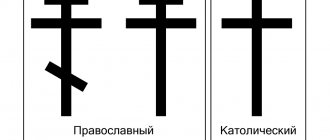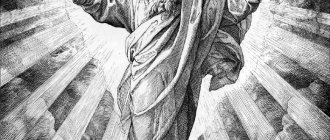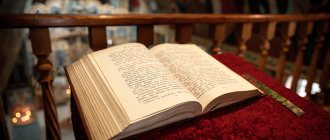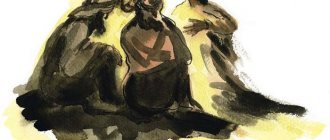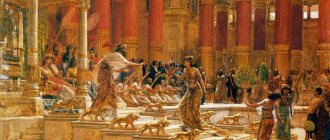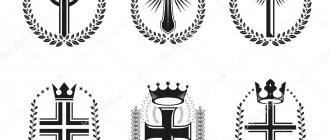Why do people in the temple pray to icons instead of God?
Priest's answer:
Dear Oksana! In your question, you touched on several different topics that are the subject of Orthodox-Protestant polemics, so I will answer them in order.
- “Why do people in church pray to icons and saints, if the Bible says that you only need to pray to one God: do not make yourself an idol or an idol?”
To more fully sanctify the essence of Orthodox icon veneration, we will divide the answer into several points:
A. Definition of icon and idol.
B. Does the Bible allow sacred images?
Q. Is prayer possible in the presence of an icon?
G. Is it permissible to venerate icons?
D. Does God accept the worship offered to Him through the icon?
A. Regarding the definition of an idol (false image) and its difference from an icon (true sacred image), the Apostle Paul writes about idols: “An idol is nothing in the world” (1 Cor. 8:4). That is, an idol is an image that does not have a prototype. For example: there is a statue of Artemis of Ephesus, Zeus and other pagan gods, but do Artemis or Zeus really exist in this world? - Of course not. An icon, unlike an idol, is an image that has its own prototype. For example: there is an icon of Jesus Christ. Christ is a real Person, like the Son of God - He is co-eternal with the Father and the Spirit. As a Man, after His Resurrection, He ascended to heaven and sits at the right hand of the Father (i.e., His human nature is glorified). There is an icon of the Mother of God, and the Mother of God herself as a person really exists, now being in the kingdom of heaven. So, by definition, it is not correct to identify icons and pagan idols. Pagans honor demons in their idols, while Orthodox Christians honor God and saints in their icons.
B. The Bible certainly allows for depictions of spiritual reality. God, who gave the commandment to Moses: “You shall not make for yourself an idol or any image...” (Ex. 20:4), immediately commands: “And you shall make of gold two cherubim...” (Ex. 25.18), which were on the lid of the ark. covenant. And God promised Moses: “There I will reveal myself to you and speak to you above the mercy seat, in the midst of the two cherubim that are above the ark of the testimony” (Ex. 25:22). The same cherubim were embroidered on the curtain that separated the holy place - the saints from the sanctuary, in the tabernacle of Moses (Ex. 26:1). In Solomon’s temple there were even more of these images: “And (Solomon) made in the oracle two cherubim of olive wood, ten cubits high (1 Kings 6:23). “And on all the walls of the temple all around he made carved images of cherubim and palm trees and blossoming flowers, within and without” (1 Kings 6:29). Although the second commandment, indeed, for the time being, forbade the depiction of God the Creator, for God, in the Old Testament period, did not appear to the Jewish people sensually, and therefore could not be depicted, but only spoke through the prophets.
C. The righteous of the Old Testament prayed in the presence of sacred images: “And I, according to the abundance of Your mercy, will enter Your house, I will worship Your holy temple in Your fear” (Ps. 5:8). The Prophet David, as we see, allowed himself to pray in the temple in the presence of images of cherubim. The Gospel of Luke ends with these words: “And they ( the apostles ) remained always in the temple , glorifying and blessing God. Amen" (Luke 24:53). This means that in the temple they too prayed to God, again, in the presence of sacred images.
D. The veneration of material shrines, including the first sacred images, took place in both the Old and New Testaments. Returning, for example, to Psalm 5, we see that David worshiped the temple. If he worshiped the temple of God, then he also worshiped the sacred images located in the temple. Also, the prophet David “played and danced” in front of the ark of the covenant, while calling it “Lord,” that is, a symbolic icon of God: “I will play and dance before the Lord!” (2 Kings 6, 21 – 22). For disrespectfully touching the ark of the covenant, God killed many of the inhabitants of Bethshemesh: “And He (God) struck down the inhabitants of Bethshemesh, because they looked into the ark of the Lord, and killed fifty thousand and seventy of the people” (1 Samuel 4:5). The Apostle Paul once arrived at the Jerusalem Temple to worship: “You can know that it was not more than twelve days since I came to Jerusalem to worship” (Acts 24:11). At the same time, he worshiped in the temple (Acts 21:26).
D. To summarize the above, we can conclude that God accepts the worship offered to Him through sacred images. On what basis? – Based on the fact that in Jesus Christ, God became Man. In several letters of the Apostle Paul, Jesus is called “the image of the invisible God” (2 Cor. 4:4; Col. 1:15), literally “image”, in the Greek text it sounds like “icon”. Does God the Father accept the worship offered by believers through Jesus Christ? - Yes, he accepts. Christians worship the invisible Father through the Incarnate Son. This means that we worship the Prototype through His Image. This is the basic principle of Orthodox icon veneration.
A few more additions to the topic raised.
Are there no direct indications in the New Testament about the making of icons of Christ? But there are no commands to write down the words of Christ, to read the words of Christ. The commandment: “Do not make yourself an idol...”, which prohibited images of the Divine in the era of the Old Testament, was abolished by the very fact of the Incarnation: if “no one has ever seen God,” but “the Only Begotten Son, who is in the bosom of the Father, He has revealed ” (John 1 ,18), becoming an icon of the Father, visibly revealed His character, intentions, Love, what prevents us now, when God has become Man, from testifying to this through icons depicting His coming in the flesh? Let then the Protestants, who accuse the Orthodox of idolatry, stop producing children's Bibles with illustrations of the Savior of the world!
Protestants are tempted by “worshipping icons instead of God.” But, firstly, we Orthodox Christians do not worship icons, but venerate them . Secondly, we worship, not instead of God, but through icons - God. Regarding the first thesis, the Bible distinguishes between two types of worship: God-worship, designated by the term “latr and a,” and reverent worship, “prask and nesis.” The first is possible only in relation to God: “Worship the Lord your God and serve Him alone (lit. latr and a) (Matt. 4:10). The second is in relation to objects reminiscent of God: “And I, according to the abundance of Your mercy, will enter Your house, I will worship (prask and nesis) Your holy temple in Your fear” (Ps. 5:8). Regarding the second thesis, the Holy Fathers of the 7th Ecumenical Council formulated the basic principle of icon veneration: the honor given to the image (icon) goes to the Archetype. This principle is unshakable in everyday life: the public burning of a photograph of the president, or the national flag of the country, will be regarded as an insult to the president himself and the state, although only a photograph and a piece of material were burned, and not a person. In the religious sphere, we Orthodox Christians do not honor the substance in the icon: wood, paint, paper, but we give honor to the Person depicted on it. With both mind and heart, from the visible image, we ascend to the Prototype.
How do we see the usefulness of icons?
1. Icon - reminds of God. It is a call to prayer.
2. Icon - teaches the truths of faith through an image, just like the Bible - through letters.
3. Icon - helps to concentrate in prayer: from the visible image to lift your mind and heart to the Prototype. Although, it is not forbidden to pray without icons.
4. Icon - kindles love for God in the same way as a photograph of a person close to us in relation to this person.
5. Icon – is an expression of the Christian faith in the Incarnation.
6. Finally, icon veneration is a way of glorifying God in the visual arts, just as we do in church singing, and so on.
2. “Why do people, instead of praying to God, turn to dead people?”
Here, as I understand it, you mean the church practice of prayers to departed saints. The answer is simple. The Apostle James in his Catholic Epistle writes: “ Pray for one another so that you may be healed: the fervent prayer of the righteous can accomplish much ” (James 5:16). Jesus Christ Himself instructs: “For where two or three are gathered in My name , there I am in the midst.” them" (Matt. 18:20). But the prayer of Christians for each other, according to the teachings of Orthodoxy, is not limited only to members of the earthly Church. This prayerful communion also includes members of the Heavenly, or Triumphant, Church: the saints. How do we know this? – From the words of Christ: “God is not the God of the dead, but of the living” (Matthew 22:32). “God has united the things in heaven and on earth under the head of Christ” (Eph. 1:10). This means that the Savior unites the earthly and heavenly Church in Himself, and there is no impassable gulf between their inhabitants, and the saints who have passed into eternity are alive before God. The Apostle Paul writes: “Love never fails” (1 Cor 13:8), which means that the saints who have achieved salvation are not indifferent to the fate of their brothers living on earth, for they continue to love them. Finally, from the Revelation of St. John the Theologian, we know that the saints - representatives of the Heavenly Church, together with the angels, pray for those living on earth: “And another Angel came and stood before the altar, holding a golden censer; and a great deal of incense was given to him, so that with the prayers of all the saints he would place it on the golden altar, which was in front of the throne. And the smoke of incense ascended with the prayers of the saints from the hand of an angel before God ” (Rev. 8:3 - 4). In a strict understanding, we Orthodox pray only to God, but we include in the circle of our co-workers those who pray to Him and the saints. Protestants do the same, but for some reason the circle of their co-prayer books is limited only to living members of the community, although God, about the power of the prayer of the righteous, says: “And it came to pass after the Lord had spoken those words to Job, that the Lord said to Eliphaz the Temanite, “Wrath burns.” Mine is against you and your two friends because you have not spoken as truly about Me as My servant Job. Therefore take for yourselves seven bulls and seven rams, and go to My servant Job and offer a sacrifice for yourself; and My servant Job will pray for you, for only his face will I accept , so as not to reject you because you have not spoken as truly about Me as My servant Job has” (Job 42:7 - 8). So the Orthodox Christians ask the deceased saints to pray to God with them. Is this a sin? If so, then let the Protestants not ask their fellow believers to pray for their needs. After all, such a petition is already a prayer of a creature, besides the Creator! If Protestants recognize the biblical practice of praying for each other, then let them not accuse the Orthodox of calling upon deceased saints for help.
For a more detailed acquaintance with these issues, I recommend reading the book by Deacon Andrey Kuraev: “For Protestants about Orthodoxy” https://predanie.ru/kuraev-andrey-protodiakon/protestantam-o-pravoslavii/, as well as the book by priest Sergei Kobzyr: “Why can’t I remain a Baptist, and a Protestant in general” https://l.120-bal.ru/pravo/18674/index.html
How does an icon differ from a simple image?
How does a holy image differ from any other image? The reasons for the veneration of icons cannot be understood without this explanation. Obviously, not only the subject of the image, although they too. A consecrated image cannot be, like a painting, only a source of aesthetic, sensory experience. Therefore, the main purpose of any sacred image is prayer in front of it, and not the decoration of a temple or home.
The iconographic image directs the mind and heart of a person to spiritual contemplation, refers to the invisible, supersensible world. The basis of such an image is always a symbol that connects the external world with the spiritual, invisible. Holy icons have the power of grace emanating from the one who is depicted on them. Therefore, when people pray, they worship not the material itself, the board and the paints, as they like to say, but those who are depicted on them.
Heresy of iconoclasm
From the first century A.D. to the 8th century, icon painting became widespread, especially given the brutal persecution of the first centuries and the desire of people to pass on the feat of faith of the martyrs to generations. Images begin to appear in churches and monasteries, and this art begins to flourish among monks who devote their lives to prayer and preaching the Gospel through drawing.
However, there was constant disagreement within the body of the Church, and many began to accuse others of idolatry. Opponents of Christianity also began to strive to destroy all manifestations of this religion, and did everything possible to kill the masters and destroy the holy faces themselves. This movement rapidly spread throughout the territory of Byzantium in the 8th-9th centuries and became known as iconoclasm.
Causes
Many theologians tend to consider one of the most important reasons for the emergence of iconoclasm to be a misunderstanding of the creation of holy images. In the first centuries, Christianity seriously struggled with paganism, while adopting a lot from it, and people stopped clearly seeing and realizing what true Christianity is, trying to destroy everything, in their opinion, “superfluous.” In addition, the spread of superstitions from the pagans also played a role in the emergence of the heresy of iconoclasm.
Iconoclasm arose in Byzantium and was directed against the veneration of icons
One of the main opponents of panagias were emperors, since it was in the images of saints that they saw a threat to their greatness. People passed on drawings, used them to preach Christ, and all this, according to the rulers, negatively affected their power and influence. One example of such false thinking is the Emperor Leo the Isaurian, who, under the influence of superstition, decided to destroy all the images in the temples.
The main reasons for the emergence of heresy were:
- Lack of education among Christians.
- Misunderstanding of the meaning of icons.
- The influence of pagan superstitions.
- The desire to destroy the Christian faith and all its manifestations.
The heresy of iconoclasm was a third-party manifestation of persecution, as well as a lack of understanding among Christians of the importance of holy images in spreading faith in the Savior Jesus.
Resistance and persecution
A consequence of the spread of heresy, as well as the participation of rulers in it, was the persecution of those who created the images and who sought to distribute them in temples. All images that could in one way or another relate to Christianity began to be mercilessly destroyed: frescoes, icons, temple decorations, sculptures. The images were cut, burned, covered with paints, and drowned in the seas and swamps. In addition, they began to severely punish everyone who dealt with icons - people were tortured, imprisoned and executed for worshiping images.
Under the influence of superstition, the iconoclasts destroyed all the images in the temples
The monks especially suffered during the movement of the fighters, because it was they who created icons, painted temples and occupied an important position in icon veneration. Monks were publicly flogged, stoned, expelled from monasteries and killed, simultaneously destroying their works. In addition to the monks, the patriarchs also suffered, among whom were Nicephorus, Herman I, as well as the theologian John of Damascus.
When Empress Irene, the regent, took the throne of Byzantium, iconoclasm began to subside, since Irene herself was of the opposite opinion. She contributed to the holding of the Seventh Ecumenical Council in 787, at which the iconoclasts were anathematized and the dogma of icon veneration was adopted. The Council allowed the creation and use of images of Christ, the Mother of God, holy martyrs and angels in divine services, since this is not idolatry.
Important! According to the resolution of the Council, the honor given to the image is transferred to its real prototype, i.e. honor to the icon of Christ is transferred to the Savior Himself.
What does it mean to honor the image of God?
It is obvious to true admirers and creators of icons: icon painting is not about portraiture, about illustration. Icon veneration does not come down to kissing icons, censing them, lighting candles, or lighting lamps in front of them. Honoring the image of God in spirit and truth (John 4:24) means for all Christians to strive to recreate Him in themselves and in the world, returning the world to God, deifying it. The main shrine in the world of God is man. In this sense, all Christians should be creators—icon painters and restorers of the image of God. According to the Holy Fathers, “each of us is an icon painter of our own life.” And the connection between the commandment of love for God and neighbor with veneration of the image of God revealed in man, that is, with love for Him, becomes clear. Therefore, the Church does not call artists true icon painters, creators, but the Holy Fathers, who fulfilled these commandments and showed us the image of God in themselves. The responsibility of church artists when painting icons is to be faithful to Tradition, that is, to recreate in themselves the image of God, walking the patristic path, and, as a result, to give the Church and the world the opportunity to contemplate what they themselves have seen. This means accurately revealing the image of God on icons in its entirety, given to the artist in Tradition, of which the iconographic heritage is a part.
The wounded face of the Most Pure One
Another event occurred at about the same time in Nicaea. Then the enraged iconoclasts came to the house of a widow and in anger pierced the ancient image of the Mother of God that she kept with a spear. However, they were amazed that blood immediately oozed out from the wound, and they believed. Later, the woman, saving, launched this image across the sea, and it came in due time to Athos. Based on the name of the monastery, the icon received the name Iverskaya. To this day, she protects the monastery from many troubles, being its “Goalkeeper”.
Iveron Icon of the Virgin Mary
The Great Penitential Canon of Andrei of Crete
When did the very first iconographic images appear?
Despite the fact that the birth of icon painting became possible, as we said, in connection with the event of the Incarnation, in Old Testament times there were also images of ethereal forces. Thus, it is well known that the Ark of the Covenant was decorated with figures of cherubs.
Actually, the very first icon-painted face is considered to be the image that received the name “Savior Not Made by Hands” and was made during the life of Christ, when holy icons had not yet been painted. The history of the face is as follows. A certain king Abgar, who ruled Edessa, fell ill with a terrible disease, black leprosy, from which it was impossible to recover.
He had heard about the miracles that the Savior performed, and sent his artist to Him to make a portrait of Jesus Christ, since the king himself could not get to Him. Avgar believed that this would help him heal. No matter how hard the court artist tried, he could not capture the face of the Savior.
Then Jesus, seeing his desire, asked to bring water, washed his face and wiped it with a handkerchief, after which he handed this handkerchief to the artist. And a miracle happened: a face appeared on the fabric. The second miracle happened in Edessa, when the king, touching this handkerchief, was healed. This legend is another basis for the veneration of icons.
We also know that the first images of the Virgin Mary belong to the brush of the Apostle Luke and were made with Her consent. The Most Holy Virgin herself blessed the painted images with the words: May the grace of the One born of Me and Mine be with these icons!
In early Christian times, known for their brutal persecution of the faithful, a symbolic image of the Savior was common. He was depicted as the Good Shepherd with a lamb in his arms, in the form of a lamb, but most often in the form of a fish. As you know, the last word in Greek sounds like “ichthys”, and is a kind of abbreviation of the words “Jesus Christ the Son of God the Savior”. Similar images are often found on the walls of ancient catacombs.
Such symbolic designs hardly remind us of holy icons. Iconography in the proper sense was born no earlier than the 6th century. The first such images were made in the burning style (encaustic), characteristic of ancient, Hellenistic art.
In this case, the paint was mixed using heated wax. The most famous holy image of the Savior of this period is the face painted on Sinai with the asymmetry characteristic of Hellenism. Until now, this image causes a lot of controversy and discussion among researchers.
Golden hand of the Virgin Mary
When in the 8th century Byzantium was gripped by iconoclasm, which rejected holy icons, the Monk John of Damascus spoke out against this. He wrote his famous “Words” in their defense. And since John had an amazing gift of speech, and also held an honorable position under the ruler of the capital of Syria, his messages had great persuasive power. For this, the saint soon had to suffer.
Slandered by the Byzantine king through cunning, John of Damascus was severely punished: he was deprived of his right hand. However, after praying in front of the icon of the Most Pure Virgin, his hand miraculously grew back and wrote many more works that defended the veneration of icons. For this miraculous healing, the monk gifted the sacred image with a poured golden hand, by which we recognize the image of the “Three-Handed One” today.
Doesn't the practice of icon veneration violate the 2nd commandment of the Old Testament?
The Second Commandment of the Old Testament sounds like this: “You shall not make for yourself an idol or any image; do not worship them or serve them.” This commandment is directed against idolatry, not icon veneration, and should be taken in context, and not in isolation from the 1st Commandment, “I am the Lord your God, and there are no other gods besides Me.”
A little history. The Old Testament, God's chosen people, to whom these commandments were originally given, were the custodians of faith in one God. He was surrounded on all sides by pagan peoples and tribes. To warn the Jews not to under any circumstances adopt pagan beliefs in idols (worship of animals, deification of material objects), God establishes this commandment.
You can remember the meaning of the word “idol” - it is a sculptural image of a pagan deity. For us, this word began to have a broader meaning - an object of adoration.
This commandment was given in the Old Testament in opposition to pagan idols and emphasized that God is indescribable, indescribable. We already live in the times of the New Testament, when the Incarnation opened up the possibility of icon veneration. God became a man (incarnated) and this allows us to depict him in the image of a man.
